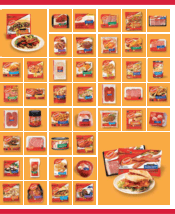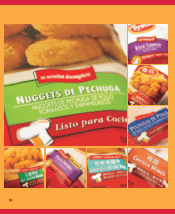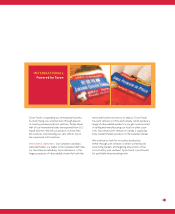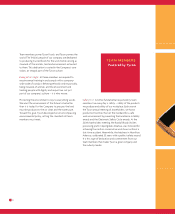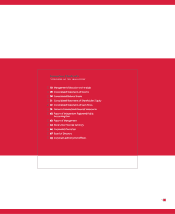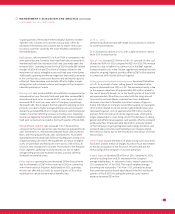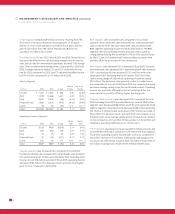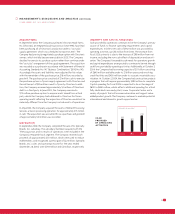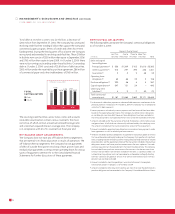Tyson Foods 2004 Annual Report Download - page 21
Download and view the complete annual report
Please find page 21 of the 2004 Tyson Foods annual report below. You can navigate through the pages in the report by either clicking on the pages listed below, or by using the keyword search tool below to find specific information within the annual report.
19
MANAGEMENT’S DISCUSSION AND ANALYSIS (CONTINUED)
Certain reclassifications have been made to prior periods to conform
to current presentations.
increased $1.9 billion or 7.7%, with a 9.4% increase in average
price and a 1.5% decrease in volume. The increase in sales primarily
is due to higher average selling prices. Volumes declined due to a
reduction in international export activity related to the Chicken
and Beef segments resulting from import restrictions imposed by
various countries. Additionally, the Company’s Beef segment domestic
volumes decreased due to tightened supply of live cattle, the effects
of higher beef pricing and significant competing protein supplies in
the marketplace.
increased $1.7 billion or 7.7%. As a percent of sales,
cost of sales decreased from 92.9% to 92.8%. The increase in cost
of sales is due primarily to increases in grain costs in the Chicken
segment, which were partially offset by gains resulting from the
Company’s on-going commodity risk management activities related
to grain purchases, and in the Beef segment, higher live cattle prices
and BSE-related charges. Also included in 2004 cost of sales were
$18 million to reduce self insurance reserves to the actuarially
determined range. The reserves are compared to actuarial estimates
semi-annually. The prior year had a $6 million reduction in self
insurance reserves. Additionally, fiscal 2003 cost of sales included
$167 million received in connection with vitamin antitrust litigation.
increased $49 million
or 5.9%. As a percent of sales, selling, general and administrative
expenses decreased from 3.4% to 3.3%. The increase in expenses
primarily was due to an increase in personnel and incentive-based
compensation of approximately $40 million, an increase of approxi-
mately $20 million related to information system technology
improvements, an increase of approximately $21 million in employee
benefit costs, primarily due to prior year actuarial gains of $13 million
related to certain retiree medical benefit plans and current year
increases in healthcare-related costs. The increases were partially
offset by a reduction in auditing, legal and professional fees of
approximately $27 million, which included $12 million received
in fiscal 2004 related to legal settlements from the Company’s
insurance providers.
include plant closing costs of $40 million and
$76 million recorded in fiscal years 2004 and 2003, respectively.
Fiscal 2004 costs were related primarily to the closings of the
Company’s Jackson, Mississippi, Manchester, New Hampshire and
Augusta, Maine, facilities. As part of its on-going plant rationaliza-
tion efforts, the Company announced in February 2004 its decision
to consolidate its manufacturing operations in Jackson, Mississippi,
into the Company’s Carthage, Mississippi, facility. The Company
acquired the Carthage facility when it purchased Choctaw Maid
Farms in the fourth quarter of fiscal 2003 and, since that time,
performed a comprehensive analysis of all operations in the area
and determined this consolidation would most effectively maintain
the Company’s competitiveness in its Mississippi operations. In
December 2003, the Company announced its decision to close its
Manchester, New Hampshire, and Augusta, Maine, Prepared Foods
operations to further improve long-term manufacturing efficiencies.
After thorough analysis, the Company determined that the amount
of capital required to bring the Manchester and Augusta facilities
to a competitive level and to maintain appropriate food safety
standards, would be better spent to accommodate production in
newer more modern facilities. The majority of the Manchester and
Augusta production was consolidated into other Company facilities.
The prior year costs were related to the closings of the Company’s
Berlin, Maryland, Stilwell, Oklahoma and Jacksonville, Florida, facili-
ties. Also included in other charges for fiscal 2004 were $25 million
in charges related to the impairment of various intangible assets
and $21 million related to fixed asset write-downs. The impairment
charges apply primarily to trademarks acquired in the acquisition
of Tyson Fresh Meats, Inc. (TFM; formerly known as IBP, inc.) in 2001.
These impairment charges resulted primarily from lower product
sales under some of the Company’s regional trademarks as prod-
ucts are increasingly being sold under the Tyson trademark. The fair
value of the Company’s trademarks is determined using a royalty
rate method based on expected revenues by trademark. The trade-
marks, as well as all other intangible assets, are reviewed at least
annually for impairment. The fixed asset write-down was the result
of the Company implementing a control whereby all plant facilities
conduct fixed asset inventories on a recurring basis.
decreased $21 million or 7.1%, primarily resulting
from an 8.2% decrease in the Company’s average indebtedness.
The Company incurred $13 million of expenses in each fiscal year
of 2004 and 2003, related to the on-going efforts to buy back bonds
at attractive prices when available in the market and to the early
redemption of Tyson de Mexico preferred shares. The overall
weighted average borrowing rate increased to 7.7% from 7.4%,
primarily due to the fiscal 2004 reduction of short-term debt which
carried lower interest rates.
decreased $3 million from the same period last year,
primarily resulting from the $10 million write-down related to the
impairment of an equity interest in a live swine operation recorded
in fiscal 2003. This decrease was partially offset by increased foreign
exchange losses of approximately $9 million from the Company’s
Canadian operation in fiscal 2004.
increased from 35.5% in fiscal 2003 to 36.6%
in fiscal 2004. The estimated Extraterritorial Income Exclusion (ETI)
amount reduced the 2004 effective tax rate by 0.5% compared to
1.9% in fiscal 2003. The decrease in the 2004 estimated ETI benefit



